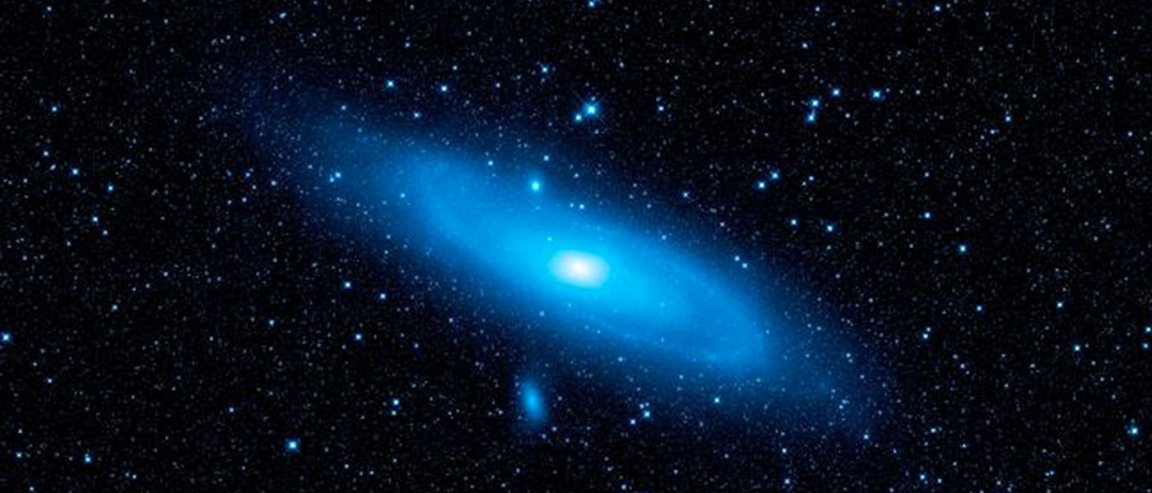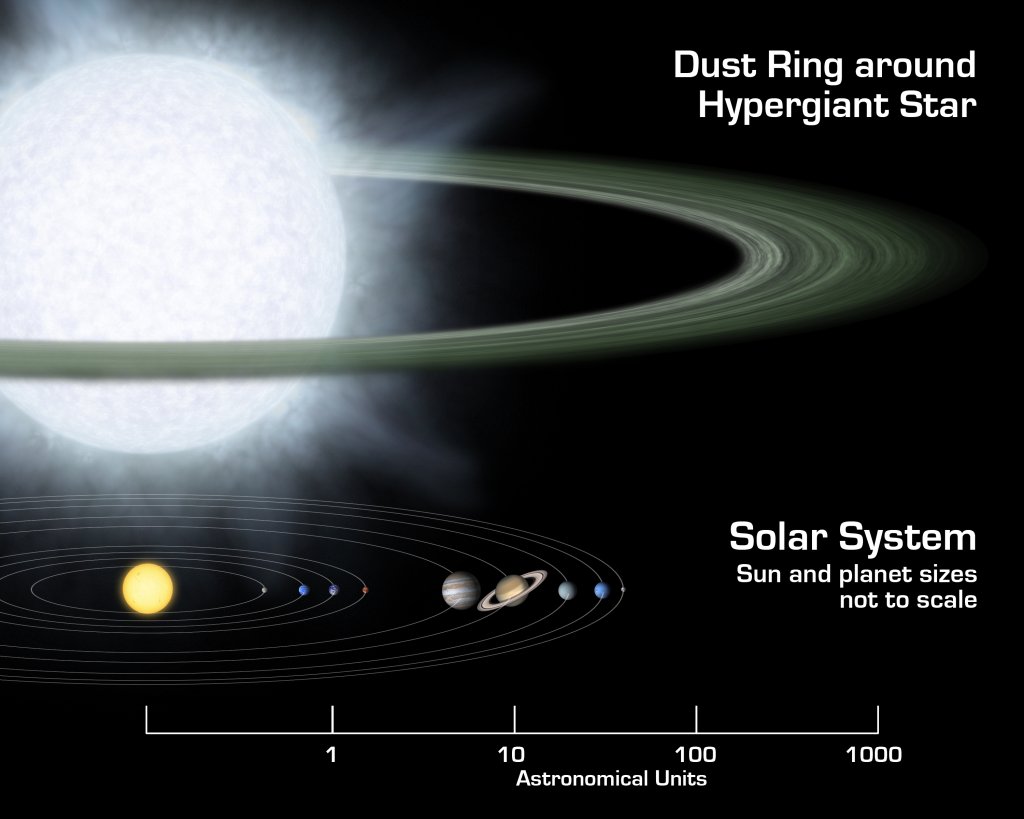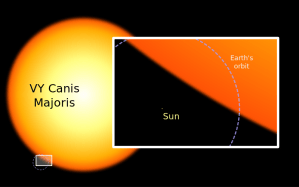
This may come as a shock, but we haven’t actually discovered everything in the universe (we can’t even see all of it). We’ve had quite some time to discover objects in space – and really, we should have discovered everything by now. But we haven’t. It is unfortunate, and it is terribly unacceptable, but there you have it.

So, when scientists say things like “this is the largest star in the known universe,” try and remember that we don’t know about all the stars in the universe. There could be a larger star lurking out in the cosmos, just waiting to be discovered. For now, the following are currently known to be the largest objects in the known universe.
The Largest Structure in the Universe

Astronomers recently discovered a group of active galactic cores that stretch more than four billion light-years end to end. And of course, by “active galactic cores” they mean massive black holes that are currently in the process of eating their way across the universe.
The structure is knows as a large quasar group (LQG), and it is simply huge. For comparison: the Milky Way (our lovely home galaxy) is about 100,000 light-years across. Our closest neighboring galaxy, Andromeda, is some 2.5 million light-years distant and is more than twice the size of the Milky Way (about 260,000 light-years). Which means that this LQG could easily swallow Andromeda, the Milky Way, and all the space in between.
Want another comparison? The Earth itself is a little more than four billion years old. So in the time it takes light to travel from one end of this structure to the other: the Earth formed and cooled, life developed, dinosaurs sprang into existence and were summarily obliterated, humanity evolved, and civilization developed. In essence, the whole of Earth’s history is equal to the time that it takes a few photons to travel across this vast expanse.
Quasars tend to assemble in large groups. So LQGs are fairly common. However, the largest of these clusters are typically only 600 million light-years wide. The newly discovered LQG is composed of 73 quasars, and at 4 billion light-years, it makes other LQG’s look like nothing more than tiny cosmological blips.
In fact, this LQG is so large that it could upend modern cosmological theory. When you apply the Theory of General Relativity to the large-scale structure of the universe, it leads to a number of cosmological theories. Of these theories, one of the most important (indeed, the most fundamental) is the cosmological principle. This principle essentially states that, when viewed on sufficiently large distance scales, there are no preferred directions or preferred places in the universe. It is a call for basic homogeneity. In essence, the universe should look pretty much the same no matter which way we turn. We shouldn’t look in one direction and see a few spiral galaxies, then turn the other way as see a humongous quasar group traveling about the cosmos.
But that’s exactly what we see. And, scientifically, it’s kind of problematic.
The Largest Black Hole
We all know that black holes are the most massive objects in the universe. They are able to swallow entire star systems without batting an eye (black holes don’t have eyes, but if they did, we bet they could swallow star systems without batting them). But there are black holes, and then there are supermassive black holes.
Supermassive black holes are the largest black holes in the known universe. While a black hole may consume hundreds of thousands of stars and threaten entire star systems, supermassive black holes threaten entire galaxies. Generally, supermassive black holes are found at the center of galaxies, and they are capable of consuming an unimaginable amount of material—they may contain billions of solar masses.
And the largest of the large appears to be the supermassive black hole at the center of galaxy NGC 1277. It contains approximately 59 percent of the mass of the bulge of its spiral galaxy, and is estimated to be 17 billion times the mass of the Sun, making it the largest black hole ever detected. It is literally consuming its home galaxy. There are billions of stars in NGC 1277 and ten times as many planets and rocky bodies, yet, one black hole makes up 14% of the total mass. Ponder that for a moment… The size of this beast is simply staggering. In most galaxies, the central black hole takes up a mere 0.1 percent of the total mass.
NGC 1277’s black hole is large, even by black hole standards. In fact, if it were at the center of our solar system, the black hole would swallow every single planet. It is 11 times wider than Neptune’s orbit, and that’s without taking the event horizon into consideration.
The Largest Spiral Galaxy

212 million light-years from Earth, NGC 6872 drifts silently through the cosmos. At first glance, NGC 6872 seems like any other spiral galaxy. And in truth, it is like any other spiral galaxy…except that NGC 6872 is amazingly huge. In fact, astronomers recently heralded NGC 6872 as the largest-known spiral galaxy. Measuring tip-to-tip across its two outsized spiral arms, this cosmic beast spans more than 522,000 light-years, making it more than five times the size of our Milky Way galaxy (it could swallow the Milky Way, Andromeda, and still have room to spare).
What made NGC 6872 so massive? Rowdy neighbors (we’re not kidding).
According to calculations, hundreds of millions of years ago, a nearby galaxy (IC 4970) passed by NGC 6872. It was far enough away that there was no collision, but the two galaxies were close enough that the gravitational interactions between them stretched and pulled NGC 6872 into the behemoth that it is today. However, the same gravitational interactions that made NGC 6872 so enormous will also bring about the galaxy’s death. Of course, galaxies can’t actually die, but they can be ripped apart (which amounts to the same thing, really). And that’s exactly what’s happening to NGC 6872. Due to the gravitational pull of IC 4970, one of NGC 6872’s massive arms seems to be spinning off to form its own dwarf galaxy.
So NGC 6872 might not be the largest spiral galaxy for much longer.
In about four billion years, it seems that something similar will happen to our own galaxy. Recently, an analysis of Hubble measurements has revealed that the Milky Way is on a collision course with the Andromeda galaxy. Some time in the future, it is entirely plausible that we might be a part of the largest spiral galaxy. Of course, given that it will take about four billion years for the collision between the Milky Way and Andromeda to take place, it’s highly unlikely that any of us will be around to celebrate this new title (alas).
The Largest Stars

Sometimes, it’s good to be proud of what you’ve got. Earth has a lovely sun that gives us all the heat and light we need to survive. However, it’s also good to be realistic. And if we’re being realistic, then we have to admit that our lovely sun is, in fact, rather wimpy. Of course, it’s larger than a number of other stars, but it is rather average…which means that there are a plethora of stars that are far more massive.
Cut to the hypergiants.
Hypergiants are stars that have an extraordinary amount of mass and luminosity. Many of these stellar objects are so large, they could swallow almost our entire solar system. Take, for example, VY Canis Majoris. This star flies about the cosmos some 28.8 quadrillion miles from our home. Not sure how far that is?

Well, it looks like this: 28,000,000,000,000,000 (it’s quite far, really).
The extreme distance is a bit unfortunate, as it means that we can only study this star from a long way off (with currently technology, it would take millions of years to send a spacecraft to study the star). Of course, if VY Canis Majoris were in the center of our solar system, we wouldn’t have to travel at all in order to study it: it would extend far beyond the orbit of Saturn.
Currently, it takes us about eight months just to reach Mars. Yet, if Canis Majoris were our sun, both the Earth and Mars would likely be entwined in the searing hot plasma far beneath the solar surface, along with Mercury, Venus, Jupiter, Saturn, and all the various moons that orbit these bodies…so maybe we should be glad that it’s a few quadrillion miles away.
To give you some hard figures, the circumference of our Sun is approximately 4.3 million km (2.7 million miles), while VY Canis Majoris is approximately 3 billion km (1.9 billion miles). Stop and read that again. How can you possibly compare such things?
Let’s say you wanted to circumnavigate this beast. Even if you were magically transported to Canis Majoris to avoid the multimillion-year travel time, a passenger airplane traveling along the surface at an average cruising speed of 900 km/h (559 mph) would take more than 1,100 years to complete one circuit. Which means that, if you started your trip around this star on the day that the Holy Roman Empire was founded (about 962 CE), you would have just finished your journey. A similar trip around our own Sun would only take you 7 months.

However, NML Cygni is one of the largest that we’ve discovered. It has a radius about 1,650 times that of the Sun’s. If it were placed at the center of our solar System, its surface would extend beyond many of our planets. Say goodbye to Mercury, Venus, Earth, Mars, etc., and all of their various moons. This doesn’t even take into account the amazing solar storms that would emanate from this beast. If we were to consider all the stellar activity, few things in our solar system would have a chance of survival.
In the end, there are a number of stars that are larger and brighter than our own middling Sun. However, in many ways, our Sun is a tad more impressive. So far, our star is the only star–and our planet the only planet–that we know of that have given rise to life. And that makes them rather awesome.